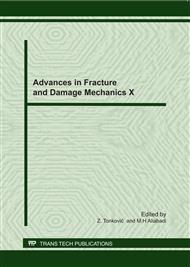p.502
p.507
p.511
p.521
p.525
p.529
p.533
p.537
p.541
Fatigue Growth Models for Multiple Long Cracks in Plates under Cyclic Tension Based on ΔKI, ΔJ-Integral and ΔCTOD Parameter
Abstract:
This paper presents the implementation of fatigue crack growth power law equations based on ΔK, ΔJ-integral and ΔCTOD fracture mechanics parameters determined in an FE analysis, to plates with multiple site damage (MSD). Results of fatigue tests with constant amplitude tensile loading carried out on mild steel plate specimens damaged with a single central crack and with three collinear cracks are presented. A relatively larger plastic zone occurred in the crack tip region at higher fatigue crack growth rate (FCGR), from 10-7 to 10-6 m/cycle. The crack growth models based on the elastic-plastic fracture mechanics (EPFM) parameters describe better fatigue crack growth in this range as compared to the liner elastic models.
Info:
Periodical:
Pages:
525-528
Citation:
Online since:
September 2011
Authors:
Price:
Сopyright:
© 2012 Trans Tech Publications Ltd. All Rights Reserved
Share:
Citation:


